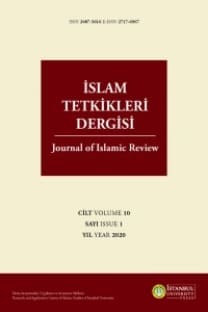Hudûs-i Dehrî Teorisi ve Eleştirileri: Canpûrî Fârûkî (ö. 1062/1652) ve eş-Şemsü’l-bâziġa Örneği
Hudûs-i dehrî, Sermed, Dehr, Zaman, Öncelik ve Sonralık, Mîr Dâmâd, Canpûrî Fârûkî
The Theory of “Perpetual Creation” (Hudūth Dahrī) and the Critiques on it: The Book of Mulla Mahmūd Jawnpūrī Fārūqī (d. 1062/1652) “al-Shams al-bāzigha” as an Example
Hudûs-i dehrî, Sermed, Dehr, Zaman, Öncelik ve Sonralık, Mîr Dâmâd, Canpûrî Fârûkî,
___
- Ansari, A. S. Bazmee, “FÂRÛKĪ, Molla Mahmûd”, Türkiye Diyanet Vakfı İslâm Ansiklopedisi. 12/182. Ankara: TDV Yayınları, 1995. google scholar
- Brown, Keven Alexander, Time, perpetuity and Eternity Mir Damad’s Theory of Perpetual Creation and the Trifold Division of Existence: An Analysis of Kitab Al-Qabasat: The Book of Blazing Brands. University of California, Los Angeles, Doktoral Thesis, 2006. https://www.academia.edu/1375048/Time_perpetuity_and_eternity_Mir_Damads_theory_of_perpetual_ creation_and_the_trifold_division_of_existence_An_analysis_ofKitab_Al_Qabasat_The_Book_of_Blazing_ google scholar
- Doru, M. Nesim, “Mîr Dâmâd’ın Hudûs Konusunda İbn Sînâ’ya Yönelttiği Eleştiriler ve Hudûs-u Dehrî Görüşü”. Felsefe Dünyası 56 (2012), 249-273. https://dergipark.org.tr/tr/download/article- file/1472158 google scholar
- Fazlurrahman, “Mîr Dâmâd’ın Hudûs-i Dehrî Kavramı: Safeviler Dönemi İran’da Tanrı-Âlem İlişkisi İle İlgili Çalışmalara Bir Katkı”. çev. M. Nesim Doru. İstanbul Üniversitesi İlahiyat Fakültesi Dergisi, 27 (2012), 231-246. https://dergipark.org.tr/tr/download/article-file/10279 google scholar
- Rizvi, Sajjad, “Mīr Dāmād and al-Qabasāt: The Problem of the Eternity of the Cosmos”. The Oxford Handbook of İslamic Philosophy. ed. Khaled el-Rouayheb - Sabine Schmidtke. 438-464. Oxford: Oxford university press, 2016. google scholar
- Rizvi, Sajjad, “Mīr Dāmād in India: Islamic Philosophical Traditions and the Problem of Creation”. Journal of the American Oriental Society, 131/1 (2011), 9-23. https://www.academia.edu/1270535/Mir_Damad_in_India google scholar
- Yakışan, Nurettin, Mîr Dâmâd ve Dehrî hudûs teorisi. Erzurum: Atatürk Üniversitesi, Sosyal Bilimler Enstitüsü, Doktora tezi, 2020. https://tez.yok.gov.tr/UlusalTezMerkezi/tezSorguSonucYeni.jsp google scholar
- Yayın Aralığı: 2
- Başlangıç: 1953
- Yayıncı: İstanbul Üniversitesi
Kutbüddîn Şîrâzî’nin İşrâkî Felsefesinde Meşşâî Geleneğin Yeri
Osmanlı Kadınlarının Evlilik Bağından Kurtulma Oyunları ve Müftüler (16.-18. Yüzyıllar)
Oryantalist, Modernist ve Köktenci Yaklaşımların Tasavvuf Anlayışlarına Dair Bir Değerlendirme
Memlük Dönemi Siyaset Düşüncesi: Siyasi Temalar için Yeni Bir Tasnif Teklifi
Çareyi Başka Mezhepte Aramak: Osmanlı Aile Hukukunda Mefkûd/Gâib Kocanın Evliliği Problemi
Uluslararası Memlükler Dönemi İlim Geleneği -I (XIII. ve XIV. Yüzyıllar) 28-29 Eylül 2021/İstanbul
Hanefi Mezhebinde Yeni Bir İstidlal Yöntemi: Mezheb İçi Telfik
Arşiv Belgelerine Göre Tekkelerde Kadınlar ve Görevleri
Şâbânî-Kuşadavî Mektuplaşma Geleneğinin Devamı: Mehmet Ali Yitik’in Nuh Naci Erdem’e Mektupları
